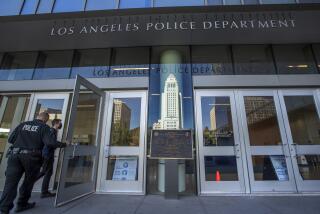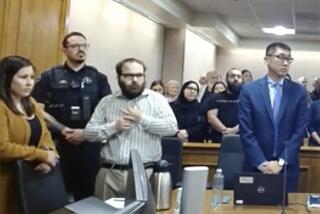Mistrial Ruled in Police Slaying of Tow Truck Driver
- Share via
A Los Angeles judge declared a mistrial Tuesday in the controversial 1992 case of a police officer who killed the unarmed driver of an unregistered tow truck, saying that jurors could not agree on whether to convict the officer of second-degree murder or a lesser charge of involuntary manslaughter.
Superior Court Judge Charles Horan said the jury had deliberated for two days before reaching a 9-3 deadlock, with the majority in favor of convicting Los Angeles Police Officer Douglas J. Iversen, 45, who is white, of involuntary manslaughter in the shooting death of John L. Daniels, a 36-year-old who was black.
At the time, Iversen said he was trying to impound Daniels’ truck, which lacked a Department of Motor Vehicles registration, and was forced to shoot Daniels out of fear that the driver was about to run over a group of pedestrians as he pulled out of a Chevron station at Florence Avenue and Crenshaw Boulevard.
But witnesses said there was no such danger, and the truck was traveling less than 5 m.p.h. One witness reported that soon after the incident, Iversen’s partner, Patrick Bradshaw, turned to him and asked: “What did you do that for?”
The slaying, which came on the heels of the 1992 riots, sparked headlines at the time because it took place less than two miles from a flash point of the civil disturbances and provoked a tense standoff between police in South-Central Los Angeles and a crowd of about 200 angry people.
The case also became one of the first important tests of the Administration of newly appointed Police Chief Willie L. Williams, as Iversen became only the second law enforcement officer in the county in more than a decade to be charged with murdering someone while on duty.
Dist. Atty. Gil Garcetti later said the shooting was not racially motivated. Prosecutors told the jury that Iversen was on an obsessive personal crusade against unlicensed tow truck drivers.
During the trial, Iversen’s attorney, John D. Barnett, called former Dist. Atty. Ira Reiner to the stand, eliciting testimony that shortly before the shooting Reiner had called for stricter enforcement of tow truck laws. At the time, Reiner said, “bandit” tow truck drivers, whose businesses are not among the city’s sanctioned network of official police garages, were a public safety concern because they were notorious for recklessly rushing to accidents in their race to get business, and one driver’s carelessness had recently resulted in the death of a child.
But Deputy Dist. Atty. Katherine Mader argued that the July 1, 1992, shooting was “out of line,” contending that Iversen had a fetish about tow truck drivers and lost his temper when Daniels dismissed his orders to stop and began driving away.
One police official testified that it is against LAPD policy for an officer to fire at a moving vehicle. The official added that Iversen and his partner had stopped to check the registration on Daniels’ truck even though they had just received an emergency call to respond to a felony in progress--an auto theft that witnesses were watching from a telephone booth.
Mader said the two officers had gotten the higher priority call and said they were on their way, “but instead decided to go to impound this particular tow truck,” a clear violation of department policy.
Prosecutors theorized that Iversen had developed an obsession about Daniels’ tow truck that dated to an earlier incident in which the vehicle had been impounded.
Two weeks before the shooting, Mader said, Iversen and his partner had chased a truck owned by Daniels’ family that reportedly had been involved in a street robbery in which Daniels was not involved.
The truck had no registration and was impounded, but was mistakenly released. Mader told the jury that when Iversen saw the truck at the service station, his intent was to get the truck back.
Witnesses said Iversen tried to pull Daniels out of the truck, and then shot him when he began to slowly pull away.
It was unclear what factors lay behind the standoff between the members of the jury, which was permitted by law to reach one of three verdicts: second-degree murder, involuntary manslaughter or not guilty. Nor was it clear whether race had anything to do with the disagreement among panel members. Three jurors were black, eight were white and one was Asian American.
Defense attorney Barnett said his polling of the jury indicated that the votes were “all over the place.” Initially, he said he was told, five jurors had favored acquittal, but voted for involuntary manslaughter in hopes of reaching a compromise with three others who were convinced that Iversen was guilty of second-degree murder because he had drawn his gun.
The jurors, who began deliberations Friday, informed the judge Tuesday morning that they were unable to reach a verdict. Horan asked the jurors to deliberate further. Shortly after lunch, the jury buzzed Horan again and informed him they remained hopelessly split, 9 to 3.
After declaring a mistrial, Horan scheduled a hearing for Oct. 24. Lawyers on both sides and members of the victim’s family said they were prepared to retry the case.
Deputy Dist. Atty. Mader questioned why the judge declared the mistrial so quickly--after just two days of deliberations. “I would have preferred that they continue to deliberate and try to reach a decision,” she said.
“This is not justice,” said Michelle Daniels, the tow truck driver’s widow. “This man executed my husband. The whole thing should be done over.”
Meanwhile, Mader said: “The jurors were very clear. All 12 believed that this was an unlawful killing. In that sense it’s not all over the map. The only confusion was as to what degree it should be.”
Iversen, who remains free on bail, had a terse “no comment” as he left the Downtown Criminal Courts Building.
Times staff writer Shawn Hubler contributed to this story.
More to Read
Sign up for Essential California
The most important California stories and recommendations in your inbox every morning.
You may occasionally receive promotional content from the Los Angeles Times.










